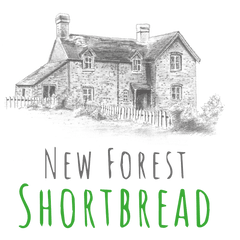The original part of this lovely, old cottage which stands deep within the inclosure, according to a stone set in the wall, was constructed in 1811 and I have often wondered why and indeed how it was built up here in the middle of nowhere and, having spent the greater part of my life in the construction industry, I for one, can really appreciate the logistical problems of building a dwelling, in those days of yore, in such a remote location,.
I imagine that the first task would have been to dig the well, by hand, of course; for without water it would have been impossible to mix the mortar with which to lay the bricks. All construction materials e.g. bricks, lime, sand, tiles, timber, etc. would have been laboriously transported by horse and cart which would have been loaded and unloaded by hand and the ability to jump in a van and pop down to the Builders Merchant for a few forgotten nails or screws was definitely not an option. So why then go to all that trouble and effort to build such a dwelling in the heart of the Forest?
The answer came from a document which was shown to me, recently, by our retired keeper Derek Gulliver and it transpires that in the early 1800’s orders were set out to appoint a number of woodmen whose duty it would be to look after the inclosures. And it was for these men and their families that a number of cottages were constructed, in or near those inclosures, throughout the Forest. Although a much respected member of Forest society, the woodman’s lot was not an easy one. For a wage of 12/- (60p!!) a week he was responsible for the felling, planting and thinning of the inclosures around his cottage; together with the upkeep of fences, drains, gates, roads, bridges and bunnies. He was expected to report and investigate any trespass against the woods and to ‘give up the whole of his time to his job’!! Furthermore, he could not take leave without prior permission and if he should be dismissed, for any reason, from his position, he would not be entitled to a gratuity.
With each cottage came a small parcel of land; a quarter acre of which was set aside as a nursery for young trees. Another quarter acre was intended for the growing of vegetables for his own use and the remainder consisted of a small paddock where he was allowed to keep one cow. However, in the mid 1800’s L. H. Cumberbatch, the Deputy Surveyor, generously decided that woodmen should also be allowed to keep a pony; but only on the condition that it was available for services to the Crown! This meant that whilst the poor woodman eventually had transport in his often remote cottage, the good, old Crown got the benefit of the use a horse and cart at no additional cost!!
On the basis that growing crops on the paddock would take up time that the employee should be spending on his job, it was forbidden to plough and cultivate the paddocks and one woodman, who was caught doing just that, was suspended for three or four days and then relocated to another cottage with a smaller plot! To add insult to injury, his pay was docked for the period of suspension.
When the Inclosures were eventually ‘thrown open’ some of the cottages were either totally demolished or taken down and re-erected near another, new inclosure. Why this cottage was not, ultimately, demolished is not clear but records show that it was sold into private ownership in 1971 for the princely sum of £4260.00!! And I thank my lucky stars that it was.
Have a very happy Christmas.
Ian Thew












Leave a comment